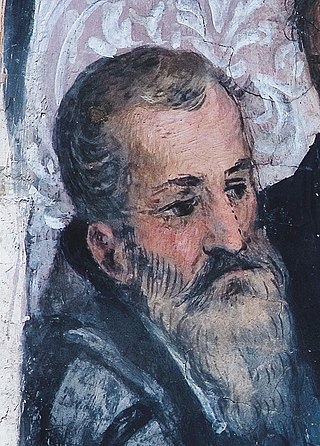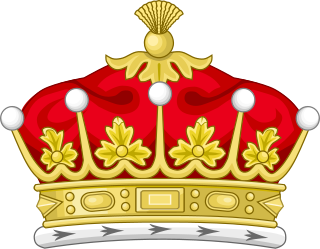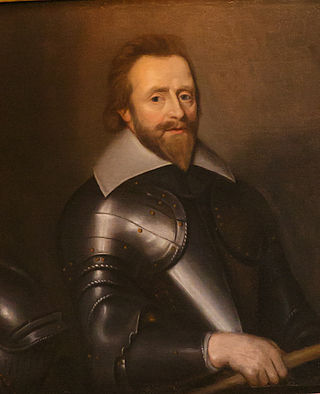
Jacob Le Maire was a Dutch mariner who circumnavigated the Earth in 1615 and 1616. The strait between Tierra del Fuego and Isla de los Estados was named the Le Maire Strait in his honour, though not without controversy. It was Le Maire himself who proposed to the council aboard Eendracht that the new passage should be called by his name and the council unanimously agreed with Le Maire. The author or authors of The Relation took Eendracht captain Willem Schouten's side by proclaiming:

Hugh O'Neill, Earl of Tyrone was a Gaelic Irish lord and key figure of the Nine Years' War. Known as the "Great Earl", he led the confederacy of Irish clans against the English Crown in resistance to the Tudor conquest of Ireland under Queen Elizabeth I.

The Flight of the Earls took place in September 1607, when Hugh O'Neill, Earl of Tyrone, and Rory O'Donnell, 1st Earl of Tyrconnell, and about ninety followers, left Ulster in Ireland for mainland Europe. Their permanent exile was a watershed event in Irish history, symbolizing the end of the old Gaelic order.

Tobias Hume was a Scottish composer, viol player and soldier.

The Earl of Tyrone is a title created three times in the Peerage of Ireland. It was created for the final time in 1746 for Marcus Beresford, 1st Viscount Tyrone, son-in-law of the last de Poer earls. His son was created Marquess of Waterford in 1789, and the title has since been a subsidiary title of the Waterford title.

William Knollys, 1st Earl of Banbury, KG, PC was an English nobleman at the court of Queen Elizabeth I and King James I.
Colonel Shane O'Neill, 3rd Earl of Tyrone was an Irish-born nobleman, soldier and member of the Spanish nobility who primarily lived and served in Continental Europe.

Alonso de Ribera y Zambrano was a Spanish soldier and twice Spanish royal governor of Chile.
William Walsh may refer to:

Arthur Chichester, 1st Baron Chichester, of Carrickfergus in Ireland, was an English administrator and soldier who served as Lord Deputy of Ireland from 1605 to 1616. He was instrumental in the development and expansion of Belfast, now Northern Ireland's capital. Several streets are named in honour of himself and his nephew and heir Arthur Chichester, 1st Earl of Donegall, including Chichester Street and the adjoining Donegall Place, site of the Belfast City Hall.
Events from the year 1616 in Ireland.
Sir William Godolphin (1567–1613), of Godolphin in Cornwall, was an English knight, soldier, and politician who sat in the House of Commons from 1604 to 1611.

Sir Oliver St John, 1st Viscount Grandison was an English soldier and politician who became Lord Deputy of Ireland.

Sir Rowland Cotton was an English politician who sat in the House of Commons at various times between 1605 and 1629.

Sir Charles Coote, 1st Baronet (1581–1642), of Castle Cuffe in Queen's County, was an English soldier, administrator and landowner who lived in Ireland. He fought in the Siege of Kinsale (1601–1602) in the Nine Years' War and led the decisive cavalry charge at the Battle of Kilrush(1642) of the Irish Confederate Wars.

Cathbarr O'Donnell was an Irish nobleman and member of the O'Donnell dynasty of Tyrconnell. His name is often anglicised as Caffar. It is latinised as Calfurnius on his tomb inscription.
Pedro Blanco was a Spanish seaman, manservant and survivor of the Spanish Armada.
Conn O'Neill, known as Conn Mac An Iarla, was an Irish soldier of noble ancestry. The eldest son of Gaelic lord Hugh O'Neill, he fought for his father in the Nine Years' War. Historian Paul Walsh described Conn as a "capable soldier".
Colonel Henry O'Neill was an Irish-born soldier and nobleman who primarily served in Continental Europe. In 1600 he was relocated to Spain to strengthen relations between his father, the Earl of Tyrone, and the Spanish government. He served for many years in the Low Countries, before dying in Spain of illness aged 23.
This page is based on this
Wikipedia article Text is available under the
CC BY-SA 4.0 license; additional terms may apply.
Images, videos and audio are available under their respective licenses.










